Address any questions or comments regarding this newsletter to the individual authors listed after each article or to its editors, Nathan Johanning, 618-939-3434, njohann@illinois.edu or Bronwyn Aly 618-695-6060, baly@illinois.edu. The Illinois Fruit and Vegetable News is available on the web at: http://ipm.illinois.edu/ifvn/. To receive or be removed from email notification of new postings of this newsletter, contact Nathan Johanning or Bronwyn Aly at the phone numbers or email addresses above.
In This Issue:
Upcoming programs (listings for beginning and established growers)
News & Announcements (2021 Illinois Specialty Crops Conference, Plastic Mulch Survey, Grape Grower Project Supports On-farm NEWA Weather Stations, Illinois Pesticide Applicator Training and Testing)
Regional Reports (SoSuCo (Matteson), west central Illinois (Quincy), southwestern Illinois (Waterloo), southern Illinois (Murphysboro), Dixon Springs)
Upcoming programs
See the University of Illinois Extension Local Food Systems and Small Farms Team’s website at:
http://web.extension.illinois.edu/smallfarm/ and the calendar of events at http://web.extension.illinois.edu/units/calendar.cfm?UnitID=629.
- 2021 Illinois Specialty Crops Conference, January 6-8, 2021. Find conference information below in News & Announcements or visit www.specialtygrowers.org/ISCC2021 for more details.
- 2021 Small Farms Winter Webinar Series, Thursdays starting at noon, from January 21 - March 25, 2021. Plan to spend your lunch hours learning more about local food and small farm related topics this coming year. Registration information coming soon!
- 2021 Kentucky Fruit and Vegetable Conference Online Every Tuesday in January 2021. For more information visit https://kyhortcouncil.org/2021-ky-fruit-vegetable-conference/
- Tuesday, Jan. 5 – General Session / Protected Ag Technologies
- Tuesday, Jan. 12 – Organic Production / Beginning Vegetable Production
- Tuesday, Jan. 19 – Advanced Fruit Production / Business Management
- Tuesday, Jan. 26 – Advanced Vegetable Production / Beginning Fruit Production
- 2021 Southern Illinois Fruit and Vegetable School, Wednesday, February 10, 2021. This will be a virtual conference that will be combining the Southern Illinois Tree Fruit School, the Southwestern Illinois Tree Fruit School and the Southern Illinois Small Fruit & Vegetable School. Save the date and be on the lookout for further information!
- 2021 25th Annual Stateline Fruit and Vegetable Growers Conference. This year, our conference will be delivered via the Zoom platform. Because of the breadth of content, our conference will be held over multiple dates. These webinars will be held live. The core of the program, fruit and vegetable disease and insect updates from Drs. Mohammad Babadoost and Kacie Athey, Extension Specialists with University of Illinois Extension, will occur on the following dates:
- Thursday, February 18 (Fruit Track) 1:00-3:30PM
- Thursday, February 25 (Vegetable Track) 1:00-3:30PM
To compliment these tracks, we have scheduled additional sessions on Fridays in February. These Zoom sessions will be held from 12-1PM.
- Friday, February 12 - Hard Cider Production, Carla Snyder, Penn State Extension
- Friday, February 19 - Pumpkin Varieties, Nathan Johanning, University of Illinois Extension
- Friday, February 26 - High Tunnel Production Updates, Bronwyn Aly, University of Illinois Extension
Registration and more information will be coming at the start of the year.
News & Announcements
2021 Illinois Specialty Crop Conference Connecting Growers Near And Far Virtually
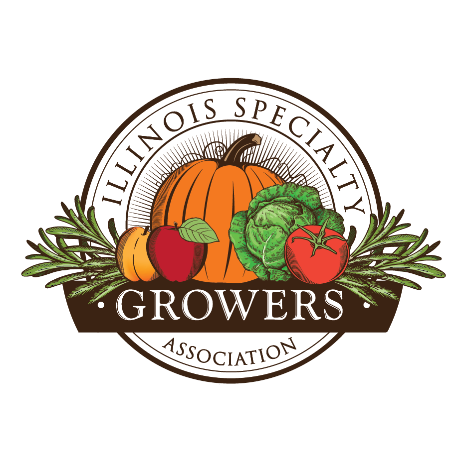
The annual Illinois Specialty Crop Conference (ISCC) will bring Illinois growers together through its new interactive, virtual format on Jan. 6-8, 2021. The conference provides a platform for education, information and networking during the ongoing COVID-19 crisis.
“Illinois specialty crop growers have faced many challenges in the wake of the pandemic,” said Raghela Scavuzzo, executive director, Illinois Specialty Growers Association (ISGA). “Now more than ever our industry has proven to be adaptive and resilient. The ISGA board of directors recognizes the industry need to continue engaging in innovative solutions with our members.”
ISCC will feature two live keynote speakers sharing insights and strategies, a roundtable discussion with live chat features, an engaging networking opportunity brought to us by COUNTRY Financial, and a robust exhibition floor where exhibitors and attendees can share business and industry information.
Sarah Frey, founder of Frey Farms, will lead the Thursday keynote as she details how her farm operation pivoted during the pandemic. Frey and her family operate farms and facilities in seven states and are headquartered in southeastern Illinois. “From farm to store to table, our specialty crop supply chain has been challenged and adapted in 2020 to ensure the delivery of fresh crops here at home and around the globe,” said Frey, who is an author, businesswoman and the country’s top pumpkin seller. “Ours is an industry that requires teamwork, and I am very excited to connect with everyone in our industry. We truly are in this together.”
The Friday keynote will be led by Chris and Angie Eckert of Eckert’s Country Store and Farms in St. Clair County as they share how their seven-generation family business worked together to respond to COVID-19. The Eckerts operate the largest pick-your-own fruit business in the country.
All in all, attendees can access three or more lives sessions daily and 60 go-at-your-own-pace virtual sessions. This marks the first-time attendees will have access to every conference session and the ability to view content at their own pace.
Registered attendees will have exclusive access to educational video presentations on leading industry topics including:
- Produce Safety Training (LIVE)
- Beginning Farmer
- Pollinators
- Berries and Beyond
- Tomatoes and Peppers
- Digital Business
- Vegetable Production
- Tree Fruit Production
- Herb and Flower Production
- Agritourism and Agritainment
- Business Development
- Of Special Interest
All the sessions will be recorded and available through password protected access to attendees after the conference. In addition, there will be fun and interactive activities including virtual games, a scavenger hunt and a virtual swag bag full of materials and giveaways.
“Members and partners need this opportunity to connect, learn and share,” said Scavuzzo. “COVID-19 has strengthened our commitment to each other and to our communities. A virtual conference is an opportunity to connect every segment of the specialty crop supply chain, from growers, shippers, processors, wholesalers, and distributors to retailers, suppliers, and partners. We are united to address our industry challenges and find solutions.”
The conference price was reduced to help ensure these educational workshops are easily accessible to our members. ISGA members receive an exclusive rate of $15 per attendee and any non-member can register for the rate of $100 per attendee.
As a reminder, ISGA membership is open to everyone, and anyone joining will have access to the reduced fee. All attendees of the virtual conference will also have access to the online conference library following the conference.
Please note you can register up to four attendees per ISGA membership. Conference registration will close Dec. 28, 2020.
Conference details and registration can be found at www.specialtygrowers.org/iscc2021 . Contact ISGA at 309-557-2107 or CBlary@ilfb.org for sponsorship and exhibitor opportunities.
Raghela Scavuzzo, Executive Director Illinois Specialty Growers Association (309-557-2155; Rscavuzzo@ilfb.org)
Raghela Scavuzzo, Illinois Specialty Growers Association Executive Director (RScavuzzo@ilfb.org)
Plastic Mulch Survey
Cornell Cooperative Extension is a partner on a Rochester Institute of Technology project that is creating new methods for manufacturing plastic mulch and promoting its field break-down. The project aims to tightly match new product development to real-world grower preferences, on-farm use patterns, and current economic constraints surrounding plastic film use. If you use plastic mulch, please take this 5-minute survey to share how you use plastic mulch on your farm!
https://cornell.ca1.qualtrics.com/jfe/form/SV_3mxuwOVlZlaxGvj
For any questions please contact Elizabeth Buck at Cornell Cooperative Extension at emb273@cornell.edu or 585-406-3419
Elizabeth Wahle, Cider Contest Coordinator (618-344-4230; wahle@illinois.edu)
Grape Grower Project Supports On-farm NEWA Weather Stations
Good news for all Illinois growers. The Illinois Grape Growers and Vintners Alliance (IGGVA) was awarded a 2020 USDA Specialty Crop Block Grant entitled Revitalizing Illinois Vineyards: Education Programs to Develop New Growers and Promote Wine-Focused Grape Production in Existing Vineyards. Included in this project happens to be the establishment of weather stations connected to NEWA (Network for Environment and Weather Applications) on three sentinel vineyards representing the north, central and southern regions of the state. The good news for all growers is the grant will pay the NEWA state-level fee for the next two years, meaning all IL growers who already have or are considering the purchase of a network weather station will not be assessed a NEWA connection fee during this two-year grant period. If you are not familiar with NEWA, this multi-state project delivers weather information and apps based on weather collected to support and advance integrated pest management (IPM) and best management practices for agricultural and green industries. If you are interested in learning more or in purchasing a NEWA compatible weather station, visit the Cornell page at http://newa.cornell.edu/index.php?page=about-newa. If you have additional questions, contact Elizabeth Wahle wahle@illinois.edu, the NEWA coordinator for Illinois.
Elizabeth Wahle (618-344-4230; wahle@illinois.edu)
Illinois Pesticide Applicator Training and Testing
From the Illinois Extension Pesticide Safety Education Program. If your Illinois Pesticide Applicator license expired in 2019 or 2020, you will need to renew. There will be no in-person PSEP Training Clinics again this year and only limited in-person testing sessions for 2020-2021. Training has moved to an online format and have been designed to prepare applicators and operators for certification exams, and they can be completed at your own pace. Testing will also be online and exams for every category of licensure will be available by early 2021. Exam sessions will be individually scheduled with a remote proctoring service. In-Person Testing will be available on a limited basis, starting January 2021 at the earliest. For complete details https://extension.illinois.edu/psep/training-testing
Growers are encouraged to register early and plan ahead if they need to renew. You have to create two accounts if you want to do the training and testing online (on account for each). This is all addressed at the website above but does take a little time hence the advice to plan ahead and not wait.
Regional Reports
From the South Suburban Cook Urban Agriculture Demonstration and Research site (SoSuCo) in Matteson, IL (Cook County)… High Tunnel Updates:The SoSuCo urban ag Extension site is officially off and running! While there are a few loose items to complete, the site is now ready to produce high-quality demonstration and research projects focused on soil and media-based urban ag production. The short-term timeline of the winter 2020-2021 will include the first winter high tunnel production demonstration at the site.
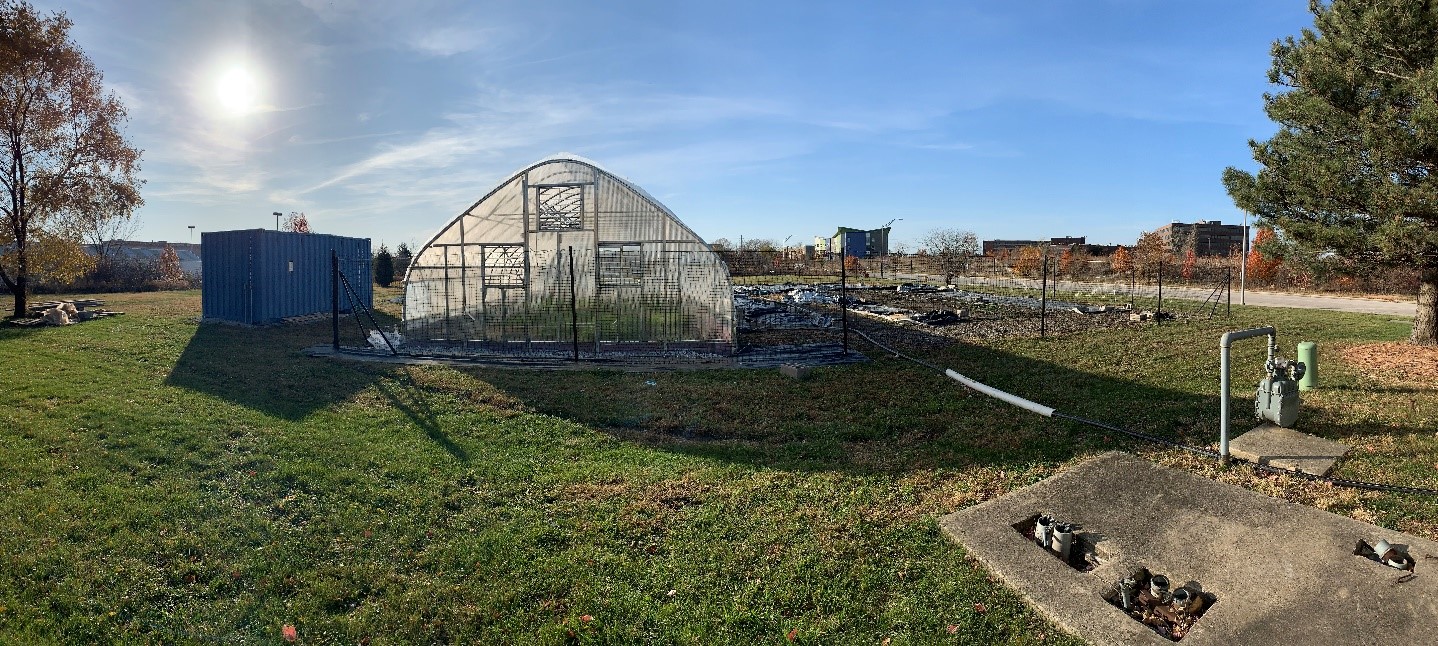
South Suburban Cook Urban Agriculture Demonstration and Research site (SoSuCo) in Matteson, IL. Photo by Z.Grant.
Multiple successions of direct-seeded and transplanted crops were planted from September through October in our 20x48 high tunnel at SoSuCo. Harvests have continued since October 1st. In late November, as is standard practice for winter production in our hardiness zone 5b, a lightweight Agribon-19 row cover was added inside the high tunnel on top of low tunnel supports. Future research into row cover thickness and support options will be forthcoming. As of December 14th, temperatures under the second low tunnel layer have not fallen below 26F, whereas outdoor temps have fallen to as low as 20F. The final fall planting date of October 14th, 2020 consisted of the spinach variety Space, and a new red oak leaf lettuce variety selected at SoSuCo for extreme cold adaptability. Both plantings are currently yielding baby-sized greens for harvest. Unheated tunnels are typically not planted after the middle of October, as day length is decreasing rapidly enough to not allow for sufficient growth to a harvestable stage. The next planting in these tunnels will occur in mid-December to early January. This will consist of an extra early carrot planting. Carrots will germinate in a wide range of soil temperatures approaching 32 F, though significant growth will not be anticipated until late January into early February. This planting should yield an exceptionally early carrot crop. Other successions of cold-hardy crops will begin again in February when day length surpasses 10 hours.

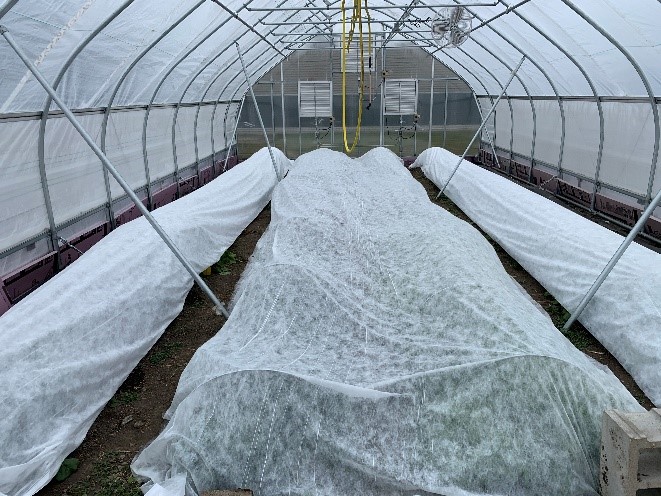
Left: Spinach and lettuce plantings in the SoSuCo high tunnel. Right: Row cover over fall plantings for winter protection. Photos by Z. Grant.
Some pest pressure has already been observed this fall and early winter. Great efforts were made in constructing the tunnel at SoSuCo to exclude insects and mammals. These exclusion tactics primarily consisted of greenhouse screening for the roll up sides. However, the end wall vent louvers and exhaust fan do not yet have screening. Additionally, an unfinished drainage trench around the perimeter with aluminum flashing and gravel likely allowed areas for small mammals to infiltrate.
I have observed both moderate aphid pressure and vole damage in the high tunnel this fall and winter. The aphid pressure is only cosmetic and the vole damage minimal. Some aphid parasitization was observed, and three neem oil applications were used to reduce aphid numbers. Renewed efforts of augmentative biological control will be implemented in late winter when average temperatures increase to aphid parasites' preferred range.
Vole damage and infiltration are being addressed by completing the perimeter drain channel and flashing. Additionally, a novel high tunnel vole trapping technique is being tested in the high tunnel. This technique involves building a "vole run trap box" with rough-cut openings in either end to encourage vole entrance. Voles have an instinct to scurry into protected coverings along the perimeter of their runs. Traps are set just inside the openings tocatch the voles. So far, this technique has met with success. Progress will be conclusive when the high tunnel's perimeter is finally sealed, and no additional voles are trapped.

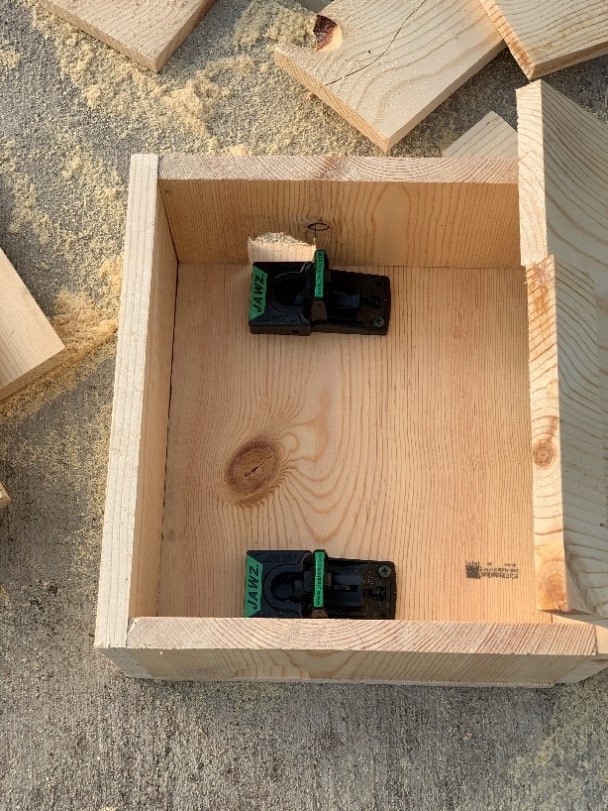
Left: Aphids observed on fall planted crops; right: “vole run trap box” constructed to help eliminate vole pests in SoSuCo high tunnel. Photos by Z. Grant.
Zachary Grant (708-449-4320; zgrant2@illinois.edu)
From west Central Illinois (Quincy)… What a year 2020 was. A year of extremes, a year of frustration, but at the end, it was a year that was profitable. This spring we couldn’t find the faucet to turn off the water, it seemed like it rained every other day. Crops were sometimes planted under less than ideal conditions, and stands suffered at times.
We started off the year with asparagus, beginning harvest mid-April, just after quarantines for Covid began. We were wondering how this might affect the ability to sell the crop, but turns out, we’ve never sold as much asparagus out of our shed (retail) as we did this year, which meant less wholesaled to the stores. It seemed that people, since they had the time and restaurants were somewhat closed, began to cook again. Which is a great thing. I‘m hoping that those skills won’t be something that consumers will put aside anytime soon.
The next crop to mature was strawberries, beginning in late May, which was a later than normal harvest due to the cool conditions of spring. We started strawberries in 1995, so this was our 25th year, and as it turns out, was our last. We’re just getting older and it’s becoming harder to find help. We had 2 acres for many years, but the last few we’ve been cutting back, and this year only had .25 acres. As a result, we only picked every 2-3 days and scheduled sales accordingly. Which made selling during the Covid times fairly easy. We just let everyone know that we’d sell at a certain time on a certain day, and to line up in cars. Never been as easy to sell as this year. I mentioned earlier this year that Quincy had a robust strawberry industry. Back in the 1930’s Quincy shipped out 500,000 quarts via railroad annually. Sad to say, but we were the last strawberry operation.
We had stand and fertility issues with the sweet corn crop, just too much rain caused plant populations to be reduced and we lost nitrogen. As a result, our wholesale business was almost non-existent, but we did manage to keep up with demand at the shed for retail. The other summer crops also sold very well, and I heard similar stories from other producers, which indicated to me that consumers were still in the mood to buy and use local foods.
Starting the first of August, the spigot finally turned off. Going from excess soil moisture to almost drought like conditions, we ran trickle irrigation lines on our pumpkins growing at home the 3rd week of August. Those pumpkins growing at a remote location didn’t get irrigated and those were adversely affected to a degree. On hillsides (thin soils) sizing was much reduced. But this year was one of the better years for pumpkin set with a great crop. The weekend crowd was good, with most folks maintaining social distancing issues. But due to schools cancelling field trips, our weekday income was down considerably. We did still get a few field trips, mostly from Missouri schools, and we had some home schools as well.
With the issuance of CFAP monies, plus the added bonus of consumers buying local, most folks should find 2020 was a good year. Certainly better than what I thought it would be this spring, looking out the window at the rain falling, wondering when I’d be able to get back into the fields.
Now we’re looking through the seed catalogues and figuring out what specific varieties we want to plant in 2021. It will be different not being able to talk to the sales reps during the Specialty Conference, but they’re only a phone call away. But I will miss the candy jars that most had with their booths!
Mike Roegge, Retired Extension Educator & Mill Creek Farms (roeggem@illinois.edu)
From southwestern Illinois (Waterloo)… Well 2020 is finally winding down certainly the growing season itself has been memorable with late & early frost and times of “drought” and “flood” as far as field conditions go and much in between. Of course, the growing season is probably the last thing that will stick in many of our minds about this year!
While conditions have varied, I would say we are fairly “average” overall on our weather. November as a whole was somewhat warm and we had quite a bit of sunny days. We got our first “winter cold” in the first few days in December with temperatures dropping down to the low 20s for a few nights. From there things moderated for a while and now this week we are back to highs in the upper 30s to 40 and lows in the 20s. Today (12/16) we woke up to our first accumulation of snow although only about ½” and it was gone by lunch time.
Out in the field, work is fairly limited but some things still going on. I did pick what will probably be the last of my fall broccoli crop which was maybe a peck or so of some sideshoots before our current cold snap. I did not cover them and the plants had showed some signs of stress from the cold. The smaller shoots were low and protected enough to be ok. From there some early pruning has started in larger orchards. Still doing some cleanup and starting to assess some “winter projects” and things to work on before next year. Personally, I have plenty of home projects for the winter, but with some time I would like to spend a day or two removing invasives and scrubby trees/brush around the farm. It hasn’t gotten as bad as it could be but looking back at old pictures you realize just how much has grown up. It’s easy to get pulled other ways and not accomplish some of these winter projects, but I haven’t ever the next year thought... “why did I take that time to fix that last winter?” Usually I’m wishing I had fixed more things!

Cereal Rye growth on trials at the Baebler Educational Farm in Waterloo, IL. Photo: N. Johanning
Fall cover crops are doing fairly well now with some moisture over the last month or two. It hasn’t been until the last few weeks that growth has really slowed with the cold. I have multiple demonstration plots along with cover crops for more tomato and pepper research for next year planted at the Baebler Educational Farm. Be watching for more observations from those trials virtually and hopefully in-person at some point.
Thank you all for your readership and support of the newsletter again this year! I look forward to at least virtually connecting with through some of our upcoming conferences. Although different this year, have a great holiday season and start to 2021!
Nathan Johanning (618-939-3434; njohann@illinois.edu)
From southern Illinois (Murphysboro)… Last week (12/10) I was mowing asparagus ferns down in a t-shirt and sunglasses, today (12/16) I’m knocking snow off the Jackson county high tunnel with a broom. While, the snow is more characteristic of this time of year, the near 70-degree temperatures of last week will certainly be missed.
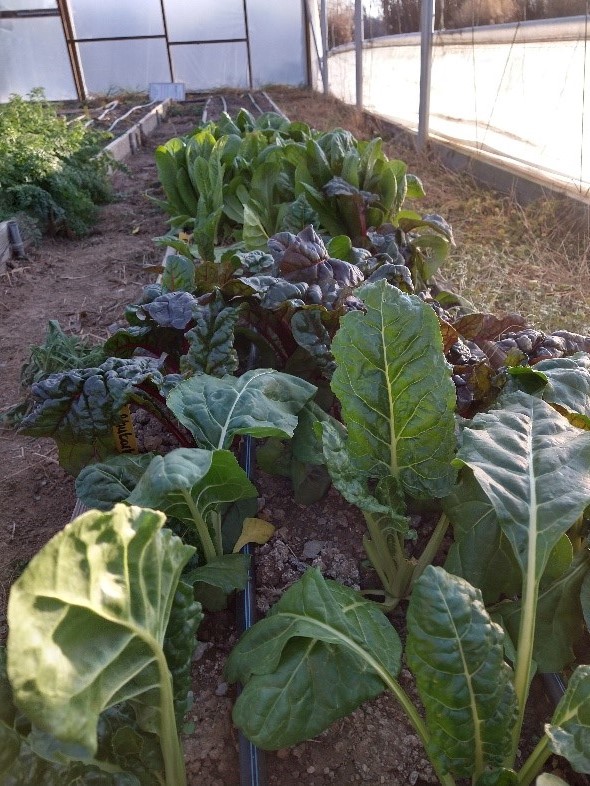
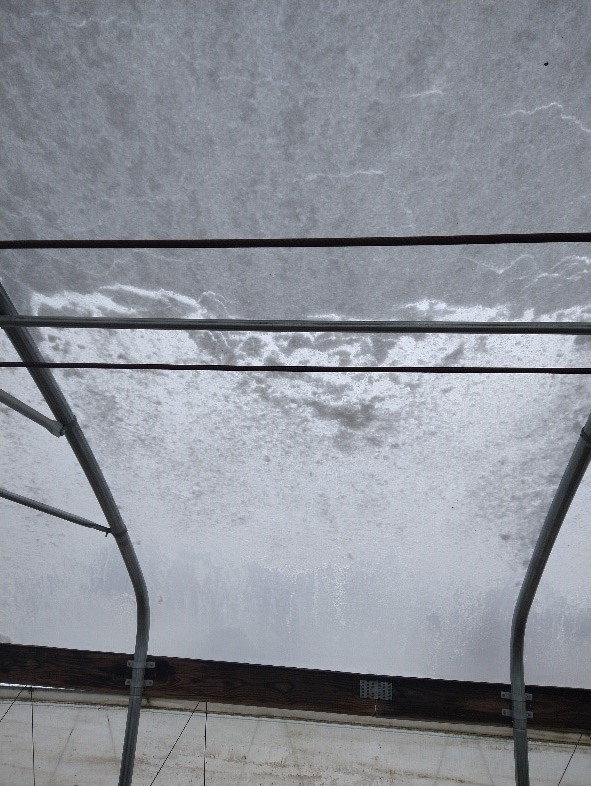
Greens (left) and snow (right) on the Jackson County High Tunnel. Photos: K. Bell
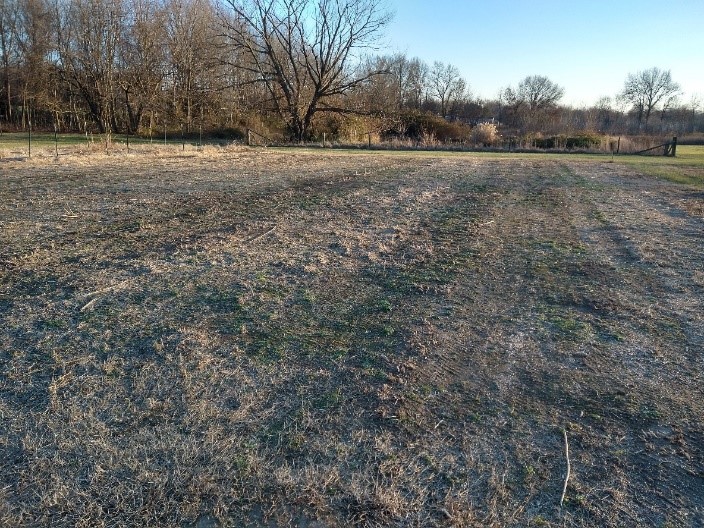
Asparagus variety trial after mowing ferns Photo: K. Bell
With this transition in weather, and the likelihood of more snow this winter; it’s important to have a plan for high tunnel snow removal. There are several things to consider when thinking about snow load on tunnels including: type of construction, amount of bracing, distribution of the snow, and weight of the snow. In general, tunnels with some type of peak will shed snow much better than those with rounded top construction. Another consideration is bow/rib spacing, closer spaced bows will make for a stronger tunnel and offer better weight distribution. The snow itself plays a big role in how critical snow removal is to your tunnel. Fluffy dry snow is much lighter than wet dense snow, therefore a few inches of very dense wet snow can be much more damaging than even a foot of dry fluffy snow. The distribution of snow should be considered when removing snow, you should try to keep the weight equal on each side as you remove the snow. Uneven snow load puts pressure on weak spots and can cause your tunnel to collapse.
Removing snow from your tunnel can be done several ways. The most important thing to remember is to use a something with a wide surface area to avoid poking holes or tearing the plastic. You want to use a wide soft bristled broom, I use a push broom, starting at the bottom work your way around the inside of the tunnel gently tapping with the bristle side of the broom. You want to clear the snow at the bottom first to allow for the rest of the snow to slide off. Another way to remove snow is by throwing a rope over the structure, and with a person on each side gently walk the snow off each end of the tunnel.
Whatever way you choose to remove snow from your tunnel be careful not to damage the plastic, unevenly weight weak points, and take breaks, it can be hard work!
Have a happy holiday season, and talk to you all next year!
Katie Bell (618-687-1727; klbell@illinois.edu)
From Dixon Springs Ag Center…We have continued to have relatively mild weather for December, with a couple of 65-70 degree days last week, although a small dusting of a snowy mix was visible this morning. How many other places in the world can you go from wearing shorts one day to cuddleduds the next just to stay comfortable while at work?
The kale, spinach, lettuce, and carrot plots included in the winter high tunnel production trial have really slowed down in growth at this time, which is to be expected with the reduced amount of daylight hours we experience this time of year. We have been working to manage a couple of pest issues this year within this tunnel. The rabbit from last year, or a close relative, made a visit back into the tunnel and managed to nimble on quite a few of the young lettuce and spinach leaves in the November planted plots. This damage will be noted in the harvest data collected from these plots as they will no doubt have reduced yields. A repellent was spread throughout the aisles within the high tunnel and red pepper flakes were scattered throughout the plots. As of today, these applications seem to have deterred our rabbit friend, unaffectionately named ‘Buck’. The other pest issue that has been challenging us this season is what we believe to be crickets chewing holes in the drip tape. Unlike drip tape damage from a mouse or vole in which tiny chew marks are visible, these creatures are causing tiny pinholes, generally in clusters of 4 or 5 in one spot. We replaced both runs of drip tape in one entire bed prior to the November planting date as the tape in this particular bed was so riddled with holes. We have since made numerous leak fixes with couplers in the new lines of drip tape. This particular bed is covered in black plastic mulch, one of the treatments in the winter vegetable production trial, so ripping or removing the plastic to search for the culprit is not an option. So far this season, insect pressure has been very low in the tunnel, with little to no sign of aphids. I anticipate more pressure once row covers need to be utilized more often and for longer periods of time (protocol for this trial has row covers being applied when temperatures are anticipated to be 25 degrees F or lower).
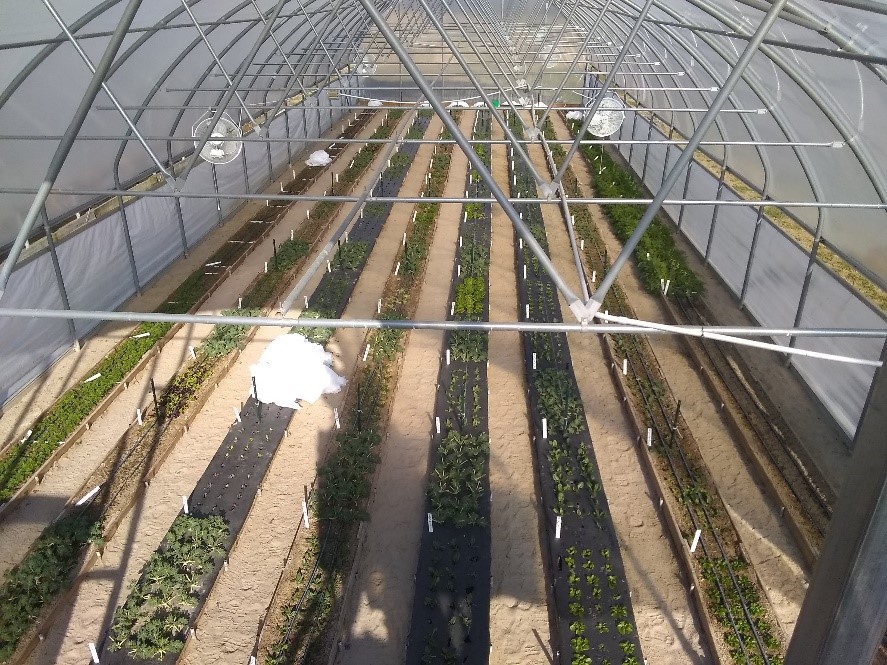
Aerial view of the winter vegetable plots taken while replacing end wall plastic. Photo by J. Zakes.
The warm, calm weather of last week allowed us time to replace the endwall plastic on the high tunnel housing the winter vegetable production trial. This plastic had several ripped areas that could no longer be mended with tape.
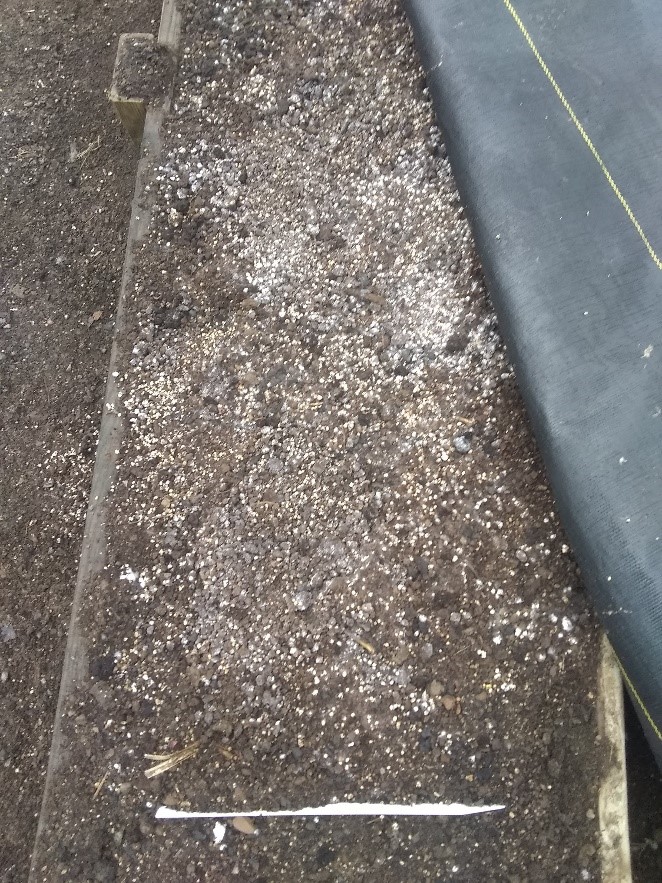
The latest installment of Local Food Happenings at DSAC discusses Winter High Tunnel Mushroom Productionand is the first of probably three total videos covering this topic. In this video, Julie Zakes talks about bed preparation, plot layout, and spawn rates used in our demonstration trial established this winter. The next videos will progress through fruiting and harvest so be on the lookout for more mushroom production updates.
I want to wish everyone a happy holiday season as we come to the end of a quite memorable year, and I look forward to sharing new updates for the 2021 season. Be well and stay safe!
In the mushroom demonstration plots in the high tunnel at DSAC, spawn were distributed at two different rates (1 pint per 10 square feet and 1 quart per 10 square feet). The photo shows the spawn starting to colonize and firm up within one of the plots. Photo by J. Zakes.
Bronwyn Aly (618-382-2662; baly@illinois.edu)
Less Seriously
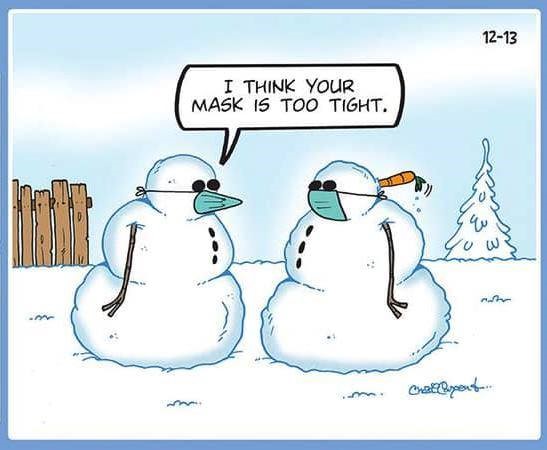
University of Illinois Extension Specialists in Fruit and Vegetable Production & Pest Management
Extension Educators – Local Food Systems and Small Farms |
||
Bronwyn Aly, Gallatin, Hamilton, Hardin, Pope, Saline, and White counties |
618-382-2662 |
|
Katie Bell, Franklin, Jackson, Perry, Randolph, & Williamson counties |
618-687-1727 |
|
Sarah Farley, Lake & McHenry counties |
847-223-8627 |
|
Nick Frillman, Woodford, Livingston, & McLean counties |
309-663-8306 |
|
Laurie George, Bond, Clinton, Jefferson, Marion, & Washington counties |
618-548-1446 |
|
Zachary Grant, Cook County | 708-679-6889 | |
Doug Gucker, DeWitt, Macon, and Piatt counties |
217-877-6042 |
|
Erin Harper, Champaign, Ford, Iroquois, and Vermillion counties |
217-333-7672 |
|
Grace Margherio, Jackie Joyner-Kersee Center, St. Clair County |
217-244-3547 |
|
Grant McCarty, Jo Daviess, Stephenson, and Winnebago counties |
815-235-4125 |
|
Katie Parker, Adams, Brown, Hancock, Pike and Schuyler counties |
217-223-8380 |
|
Kathryn Pereira, Cook County |
773-233-2900 |
|
James Theuri, Grundy, Kankakee, and Will counties |
815-933-8337 |
|
Extension Educators – Horticulture |
||
Chris Enroth, Henderson, Knox, McDonough, and Warren counties |
309-837-3939 |
|
Richard Hentschel, DuPage, Kane, and Kendall counties |
630-584-6166 |
|
Andrew Holsinger, Christian, Jersey, Macoupin, & Montgomery counties |
217-532-3941 |
|
Extension Educators - Commercial Agriculture |
||
Elizabeth Wahle, Fruit & Vegetable Production |
618-344-4230 |
|
Nathan Johanning, Madison, Monroe & St. Clair counties |
618-939-3434 |
|
Campus-based Extension Specialists |
||
Kacie Athey, Entomology |
217-244-9916 |
|
Mohammad Babadoost, Plant Pathology |
217-333-1523 |
|